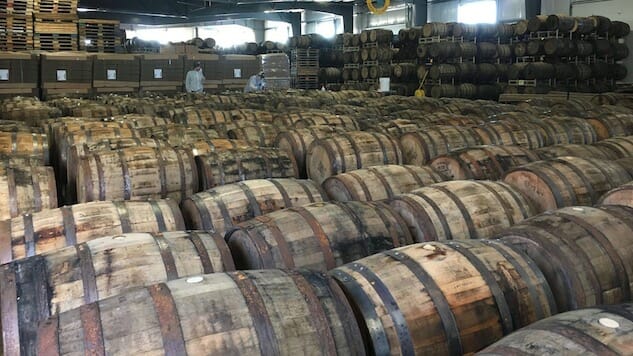Central Waters has Become a Barrel Aging Behemoth
Photo via Central Waters
Central Waters is, I don’t mind admitting, a brewery with which I’ve become acquainted from a “top-down” sort of approach. What does that mean? Simply this: I went to a local beer store just a couple of months after moving to Madison, Wisconsin, determined, as we all are at some point in this process, for Founders KBS. I whiffed, repeatedly, until some exasperated clerk suggested I give the Central Waters barrel-aged series a go. And I did, picking up singles of Bourbon Barrel Stout, Bourbon Barrel Barleywine, and Bourbon Barrel Cherry Stout. Some eight months later, I was standing in the mud at Central Waters, waiting to pick up bottles of Fifteen.
I didn’t need to pre-order those bottles. One year later, Central Waters started doing online sales for their anniversary series and other special release. Sixteen lasted a good week or more; Seventeen, roughly a day; Eighteen, the last one I purchased, was still somewhat forgiving at five minutes. Today I’m sitting with co-owner Anello Mollica, a few weeks before their 19th anniversary party. The accompanying beer? It lasted all of 30 seconds. I ask Anello if they’ll just throw the 20th anniversary beer into a fire and sell tickets to smell the fumes. It’s not a good joke, and he probably won’t remember it. But he gives a sympathy chuckle anyway.
“Nobody expected this,” he says. It’s a snowy, messy December day, and the brewery isn’t open, except for production. “We figured it might be something we could hang our hats on for the future, but we never expected that it would get to this level. Especially,” he adds, “when we started doing barrel-aging in 2001, we never dreamed that it would take up 30% of our volume.”
That number, that 30%? It’s important, particularly in context. Central Waters has the fourth or fifth largest stock of oak barrels in the country. The only other breweries that match or exceed them? Goose Island, New Holland, Firestone Walker, and Founders. And that company gets even more mind-boggling when you consider that, though Central Waters and Founders have the same number of oak casks, Founders’ total brewing capacity is 200,000 barrels per year. Central Waters? 15,000 barrels per year.
Anello relates this fact to me in a way that suggests he’s long past being astounded by it, but something in his expression indicates that he is, at least, still a little dazed. It may have something to do with the initial scale.
“When we started our barrel-aging program,” he says, “we just had a handful of bourbon barrels. So we made the beer, put it out, and we sold every drop we had. Every bit of profit that we made off of that beer, though, we reinvested back into the barrel program. And we’ve been doing that for 15 years now.”
Which is why Central Waters essentially has an airplane hangar dedicated to housing their barrels. When Anello takes me back there, there is scant space to walk around, let alone fit even more product. Somehow, though, they’ve found a way to continue growing the program, adding variety with rye whiskey barrels and even a handful of tequila casks. Two draft-only beers, The Promise (a barleywine of sorts) and Bloody Sunrise (a golden strong ale with agave and blood oranges) have already come out of these barrels.
The street cred for such a long-tenured barrel program is obvious. But there are other, more practical advantages for having been around so long. Bourbon barrels used to be gotten with a song and a handshake. Now, thanks in large part to so many more breweries experimenting with bourbon barrels, plus the rise of single malt production outside of Scotland—mainly in Japan—they are at a premium.
“We used to be able to get them for $25 apiece,” Anello says. “Now, they typically run about $190.”
On top of that, they’re difficult to get. But Central Waters has been buying barrels for over 15 years now, affording them a leg up in some respects.
“We have strength in buying power, so that definitely helps,” Anello says. “And we’ve learned a lot about quality from each one of them.”
-

-

-

-

-

-

-

-

-

-

-

-

-

-

-

-

-

-

-

-

-

-

-

-

-

-

-

-

-

-

-

-

-

-

-

-

-

-

-

-








































